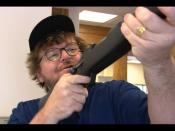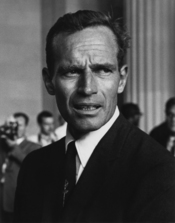Editing is the act of assembling components of a piece by cutting and splicing. As a filmmaker, and especially when making a documentary, the use of editing is very important in putting together ideas and arguments. In the case of a documentary, editing can be used to further push a thesis and prove a point which the filmmaker is trying to put across. The possibilities are endless; dialogues can be shortened, scenes can be added or cut, or even switched around to be in any order desired. By doing such things, a very plain portion of footage can be used to argue an idea. In the movie, "Bowling for Columbine," Michael Moore is a genius when it comes to his editing choices concerning Charlton Heston and the NRA. Using a few well placed insert shots Moore is able to bring the attention away from Heston long enough to change around parts of his speech and shorten dialogues.
By means of crosscuts he is able to make it seem as if though Heston is talking insensitively to the weeping children of Columbine. All of this is an attempt to incriminate Heston by deception. Moore gives the story, but emphasizes the parts that promote his argument. By means of the numerous little editing "tweaks" mentioned above, Michael Moore is able to use "Bowling for Columbine" as propaganda against the NRA and make Charlton Heston the antagonist villain.
A crosscut is a cut where the camera jumps from one scene to another and makes it seem like they are happening concurrently. Moore's first use of a crosscut to incriminate Heston is during the shooting and Denver NRA meeting scenes. At first, Moore has footage of the Columbine massacre; interviews with different people, actual footage from the school. He ends...



Excellent Job
It was a very good essay, kudos. I loved the film, and your essay most definitely made me think about why I liked it so much. After I read it, \"of course! the editing!\". Thanks.
3 out of 3 people found this comment useful.